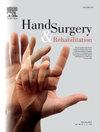Comparison of WALANT versus locoregional nerve block in staged bilateral endoscopic carpal tunnel release
IF 0.9
4区 医学
Q4 ORTHOPEDICS
引用次数: 0
Abstract
Background
Carpal tunnel release can be performed as open or endoscopic surgery. In WALANT (wide awake local anesthesia no tourniquet) a tourniquet is not used, ensuring less discomfort for the patient. In locoregional distal nerve block, on the other hand, a tourniquet is needed and can be painful. This raises the question as to which method of anesthesia is actually preferred for the patient and the surgeon. Patients undergoing staged bilateral carpal tunnel release present a unique opportunity to study this question.
Methods
Fifteen patients were included in this prospective study. The primary endpoint was the preference for anesthesia type in patients and surgeons. Surgeon preference was based on the visibility and fluency of the procedure. Secondary endpoints for patients comprised pain scores for performing surgery and anesthesia and pain caused by the tourniquet.
Results
Baseline demographic and clinical information was collected. There was no significant difference in pain for performing local anesthesia or surgery. Surgeons may find that performing endoscopic release under WALANT is more challenging, as visibility tends to be significantly poorer. The mean pain caused by the tourniquet used during the wrist block procedure was rated as 3.6. In both surgeries, 77% (10/13) of the patients preferred the WALANT anesthesia.
Conclusion
In general, endoscopic carpal tunnel release was better tolerated under WALANT than locoregional distal nerve block. Although statistical analysis showed no significant difference in visibility and fluency for the surgeon between the two anesthesia techniques, we do not recommend endoscopic release under WALANT due to the consistent report of reduced visibility in the surgical field. This limitation, likely related to the presence of anesthetic fluid, may have failed to reach statistical significance due to small sample size, but is nevertheless a considerable challenge in practice.
Level of evidence
1B.
分期双侧内窥镜腕管松解术中 WALANT 与局部神经阻滞的比较。
背景介绍腕管松解术可通过开放手术或内窥镜手术进行。在 WALANT(无止血带宽清醒局部麻醉)手术中,不使用止血带,可减少患者的不适感。而在局部远端神经阻滞术中,则需要使用止血带,而且会给患者带来痛苦。这就提出了一个问题,究竟哪种麻醉方法更适合患者和外科医生。接受分期双侧腕管松解术的患者为研究这一问题提供了独特的机会:这项前瞻性研究纳入了 15 名患者。主要终点是患者和外科医生对麻醉类型的偏好。外科医生的偏好基于手术的可视性和流畅性。患者的次要终点包括进行手术和麻醉时的疼痛评分以及止血带引起的疼痛:结果:收集了基线人口统计学和临床信息。进行局部麻醉或手术时的疼痛没有明显差异。外科医生可能会发现,在 WALANT 下进行内窥镜松解术更具挑战性,因为能见度往往明显较低。腕部阻滞手术中使用止血带造成的平均疼痛为 3.6 级。在这两次手术中,77%(10/13)的患者更倾向于使用 WALANT 麻醉:总的来说,与局部远端神经阻滞相比,在WALANT麻醉下进行内窥镜腕管松解术的耐受性更好。虽然统计分析显示两种麻醉技术在手术视野和手术流畅性方面没有明显差异,但由于手术视野视野降低的报告一直存在,我们不推荐在 WALANT 下进行内窥镜腕管松解术。这一局限性可能与麻醉液的存在有关,可能由于样本量较小而未能达到统计学意义,但在实践中仍是一个相当大的挑战:1B.
本文章由计算机程序翻译,如有差异,请以英文原文为准。
求助全文
约1分钟内获得全文
求助全文
来源期刊

Hand Surgery & Rehabilitation
Medicine-Surgery
CiteScore
1.70
自引率
27.30%
发文量
0
审稿时长
49 days
期刊介绍:
As the official publication of the French, Belgian and Swiss Societies for Surgery of the Hand, as well as of the French Society of Rehabilitation of the Hand & Upper Limb, ''Hand Surgery and Rehabilitation'' - formerly named "Chirurgie de la Main" - publishes original articles, literature reviews, technical notes, and clinical cases. It is indexed in the main international databases (including Medline). Initially a platform for French-speaking hand surgeons, the journal will now publish its articles in English to disseminate its author''s scientific findings more widely. The journal also includes a biannual supplement in French, the monograph of the French Society for Surgery of the Hand, where comprehensive reviews in the fields of hand, peripheral nerve and upper limb surgery are presented.
Organe officiel de la Société française de chirurgie de la main, de la Société française de Rééducation de la main (SFRM-GEMMSOR), de la Société suisse de chirurgie de la main et du Belgian Hand Group, indexée dans les grandes bases de données internationales (Medline, Embase, Pascal, Scopus), Hand Surgery and Rehabilitation - anciennement titrée Chirurgie de la main - publie des articles originaux, des revues de la littérature, des notes techniques, des cas clinique. Initialement plateforme d''expression francophone de la spécialité, la revue s''oriente désormais vers l''anglais pour devenir une référence scientifique et de formation de la spécialité en France et en Europe. Avec 6 publications en anglais par an, la revue comprend également un supplément biannuel, la monographie du GEM, où sont présentées en français, des mises au point complètes dans les domaines de la chirurgie de la main, des nerfs périphériques et du membre supérieur.
 求助内容:
求助内容: 应助结果提醒方式:
应助结果提醒方式:


